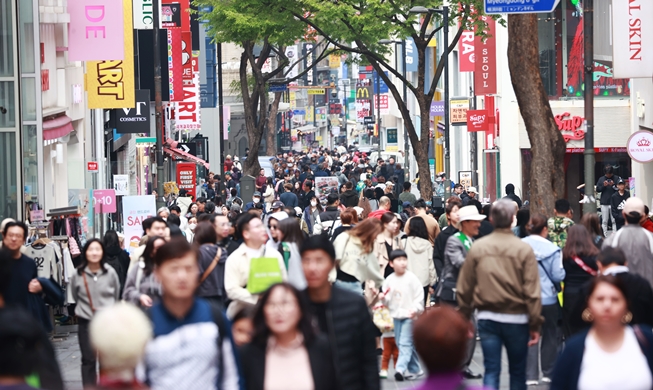-
 Korea.net's 24-hour YouTube channel
Korea.net's 24-hour YouTube channel- NEWS FOCUS
- ABOUT KOREA
- EVENTS
- RESOURCES
- GOVERNMENT
- ABOUT US
On January 19, a memorial honoring Korean anti-Japanese activist An Jung-geun (1879-1910) was opened to the public at Harbin Station in Harbin, the capital of Heilongjiang Province, in northeast China.
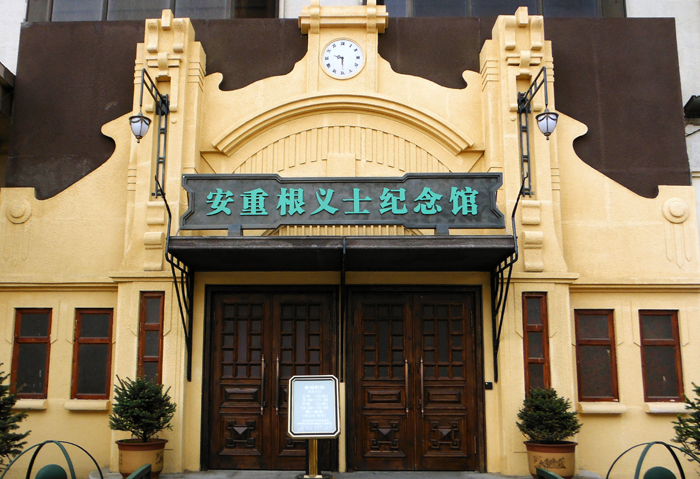
The memorial hall in honor of independence activist An Jung-geun opens at Harbin Station in Harbin, China. (photo courtesy of the Ministry of Patriots and Veterans Affairs)
The patriot was one of Korea's independence activists fighting against Japanese Imperialism (1910-1945) in the early 1900s. Born on September 2, 1879, in Haeju, Hwanghae-do (Hwanghae Province), An went into self-imposed exile in Russia's Maritime Province in 1905 when the Eulsa Treaty, a Japan-Korea "protectorate" treaty, went forcibly into effect.
There, he organized a group of like-minded independence activists and led a stream of attacks against Japanese forces across the Tumen River bordering China and what is now North Korea.
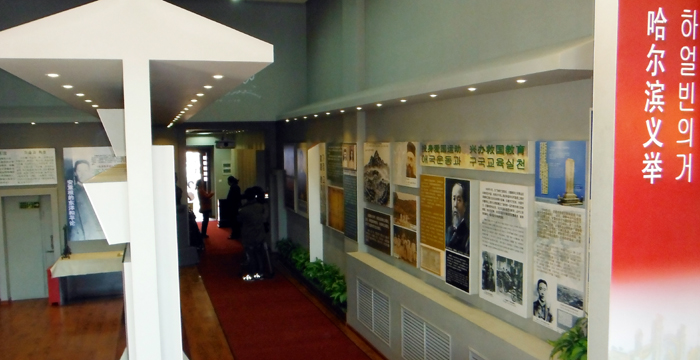
A look into the memorial hall honoring Korean independence activist An Jung-geun. (photo courtesy of the Ministry of Patriots and Veterans Affairs)
In 1909, An joined an armed resistance group, along with 11 other activists, in Kraskino, just over the border from Korea at the southern tip of Russia's Maritime Province. It was there that he got actively engaged in fights against the Japanese colonial rulers. The same year, on October 26, An shot and killed former Japanese Prime Minister and then-current Resident-General of Korea Hirobumi Ito at Harbin Station. Ito was Japan's representative in the Joseon Dynasty (1392-1910) at the time and was prime minister during some of the years prior when Japan took steps toward occupying Korea. An was arrested at the scene and after a trial and many months in prison, was executed in March 1910 at the age of 32.
The newly-opened museum, dedicated to the activist's life, is somewhat of a microcosm of exactly what the station looked like when the assassination took place.
The hands of the clock at the memorial site point to 9:30 a.m., exactly the time when the historical moment took place.
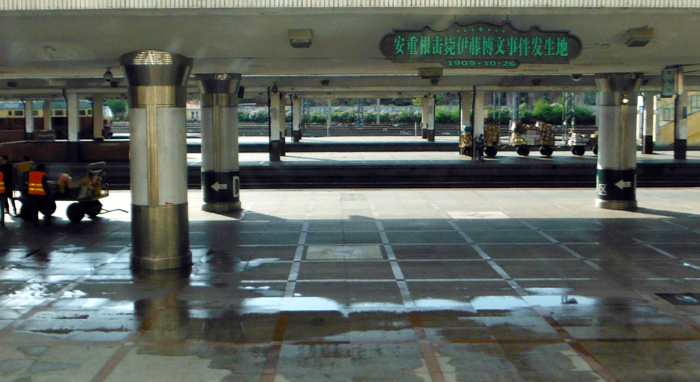
Platform 1 at Harbin Station is where independence activist An Jung-geun assassinated Japan's Resident-General in Korea, Hirobumi Ito. (photo courtesy of the Ministry of Patriots and Veterans Affairs)
The memorial hall features more than 90 exhibits tracing An's life, his patriotic activities and the historical background of the assassination up until his execution.
A delegation from the Korean government held a ceremony at the memorial site on May 9, taking the opportunity to thank the Chinese government for making the memorial hall possible.
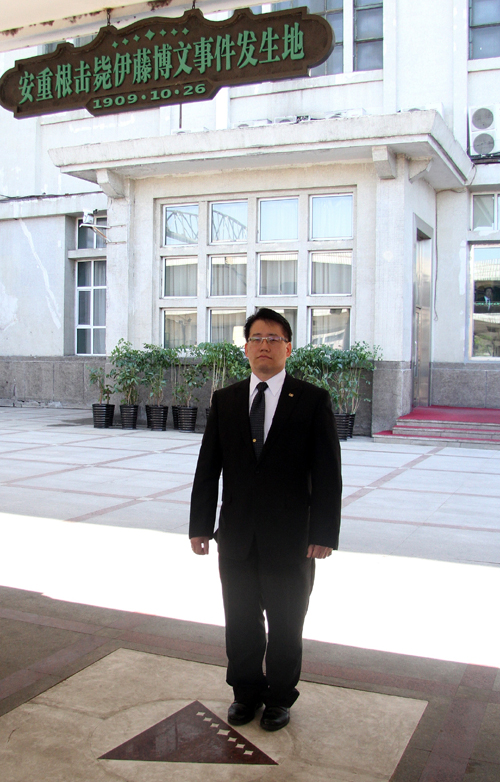
An Do-yong, great-grandson of independence activist An Jung-geun, stands at the memorial plaque on May 9 on the spot where his great-grandfather fired on Hirobumi Ito almost a century ago. (photo courtesy of the Ministry of Patriots and Veterans Affairs)
Among those in attendance at the ceremony was An's great-grandson, An Do-yong. "I am filled with emotion as I stand here, where my great-grandfather did a patriotic deed," said the younger An. "I'd like to express my heartfelt gratitude to the governments of both Korea and China for helping with the opening of the memorial hall in honor of my great-grandfather."
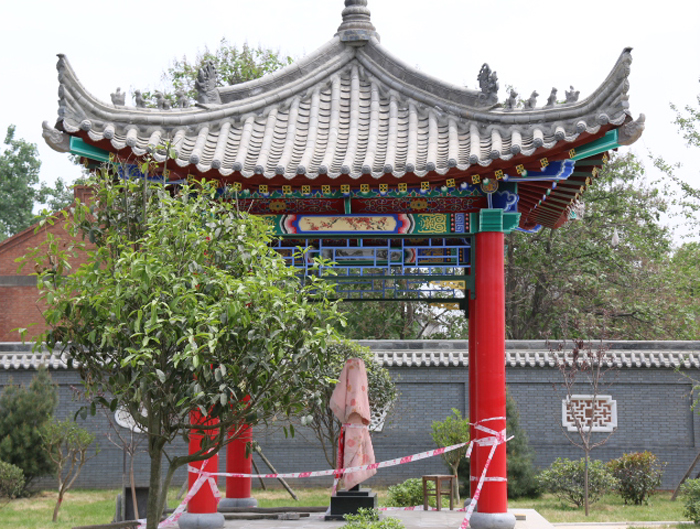
A monument dedicated to Korean independence fighters who fought under the Provisional Government of Korea is set up in Xian, Shaanxi Province, China. The monument, now covered with a cloth, is set to be unveiled to the public by the end of the month. (photo: Yonhap News)
Meanwhile, a stone monument in honor of Korean independence fighters who fought as part of the Provisional Government of Korea has been set up in Xian, Shaanxi Province, China.
The Chinese government erected a pavilion, three to four meters high, standing on four red pillars, under which the monument stands. It will be unveiled to the public at the end of this month.
It is said that the stone monument has an inscription engraved in both Korean and Chinese, verifying that the site served as a stronghold for patriots fighting for independence from Japanese colonial aggression throughout the 1930s and 1940s. The epitaph is also said to affirm the amity between Korea and China.
The Korean Provisional Government's independence armies waged a series of anti-Japanese movements across Chongqing, southwest China, in August 1940, where about 180 activists were stationed, undergoing special training.
By Sohn JiAe
Korea.net Staff Writer
jiae5853@korea.kr
Most popular
- First hearing-impaired K-pop act hopes for 'barrier-free world'
- 'Mad Max' director impressed by 'cinema-literate' Korean viewers
- Romanian presidential couple visits national cemetery
- 'Korean mythology is just as wonderful as Greek and Roman'
- Hit drama 'Beef' wins awards from 3 major Hollywood guilds




